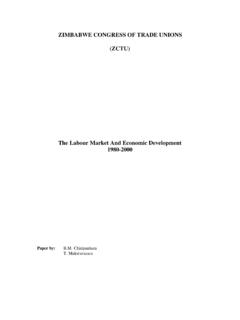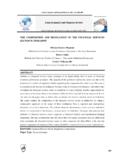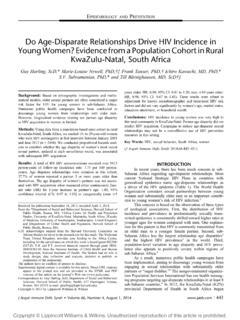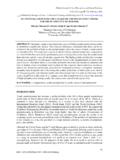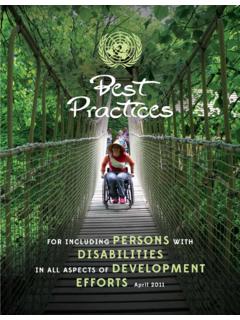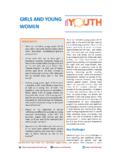Transcription of ZIMBABWE NATIONAL EMPLOYMENT POLICY …
1 ZIMBABWE NATIONAL EMPLOYMENT POLICY . framework ( zinepf ). FINAL DRAFT. APRIL 2009. MINISTRY OF LABOUR & SOCIAL SERVICES, AND MINISTRY OF. youth DEVELOPMENT, INDIGENISATION & EMPOWERMENT IN. CONJUNCTION WITH ILO/SRO. Table of Contents ..iv Executive Summary .. v Part I: The Situation Analysis Introduction and Background .. 1. Rationale for the NATIONAL EMPLOYMENT POLICY framework .. 3. Socio-Economic Context .. 5. Overall Macroeconomic 5. Growth And EMPLOYMENT .. 8. Increased Informalization of the Economy .. 14. Disability.
2 15. Hiv and Aids .. 15. The Brain Drain .. 16. Review Of Existing Policies and Programmes Affecting EMPLOYMENT .. 18. Review of the Economic POLICY framework .. 18. Review of the Institutional framework and Coordination Mechanism .. 21. EMPLOYMENT Strategies, Programmes, (Including Both Active and Passive Labour Market POLICY Measures) And Labour Market Information .. 22. Education and Training .. 27. Part II: Setting Priority Policies Problem Identification .. 33. The POLICY framework .. 36. Objectives Of The POLICY .
3 36. Principles Guiding The POLICY framework .. 37. Strategies Of The POLICY framework .. 38. Part III: POLICY Implementation Implementation and Institutional Arrangements .. 44. Resource Mobilisation .. 46. Monitoring And 46. Annex 1: NATIONAL EMPLOYMENT POLICY Action Plan .. 47. Annex 2: NATIONAL EMPLOYMENT POLICY Logical framework .. 53. Annex 3: NATIONAL EMPLOYMENT POLICY Implementation Matrix .. 60. Annex 4: Key Interventions / Strategies By Various Ministries And Other Stakeholders On EMPLOYMENT Creation .. 68.
4 Annex 5: Targeted Sectors For EMPLOYMENT Creation Identified At The Stakeholders . Validation Workshop, 10 January 2009 .. 73. List of Figures Figure 1: The relationship between Real GDP and EMPLOYMENT Growth during the period 1986-2004.. 9. Figure 2: Real Average Earnings Index (1975-2004) .. 13. ii List of Tables Table 1: Performance of the ZIMBABWE Economy, Selected Economic Indicators, 1986- 05. (Periodical Annual Averages) .. 6. Table 2: Real GDP and EMPLOYMENT Growth, 1986-90, 1991-96 and 1997-2004 .. 9. Table 3: EMPLOYMENT Elasticities and GDP Growth (%), 1991-95, 1995-99 & 1999-2003.
5 10. Table 4: Sectoral Distribution of EMPLOYMENT , Selected Periods, 1980-2004 .. 11. Table 5: Percentage Share of Female Employees by Formal Sector, 1980-2002 .. 12. Table 6: EMPLOYMENT Elasticities and GDP Growth (%), 1991-95, 1995-99 & 1999-2003 . World, Sub-Saharan Africa and ZIMBABWE .. 13. Table 7: Goals, Objectives and Key Result Areas of the Department of EMPLOYMENT Creation, 2006 .. 24. Table 8: Budgetary Allocations to various Ministries and interventions (%), 25. iii PREFACE. Like many other countries in the world, ZIMBABWE is faced with a daunting challenge of dealing with the scourge of unemployment and endemic poverty.
6 This challenge is exacerbated by the current global recession, the worst since the Great Depression of the 1930s, which started with the sub-prime mortgage crisis in the USA in August 2008. The increasing levels of global integration among nations imply that ZIMBABWE will not be spared by this crisis, especially as it relies on world markets for its primary exports. However, for ZIMBABWE , the challenge is the more formidable given the NATIONAL crisis that started in 1997, resulting in sustained negative growth since 1999.
7 This period of economic regression coincides with the recovery of growth in most Sub-Saharan African countries, above the traditional 3 percent level. As economic growth declined in ZIMBABWE , so did the labour absorptive capacity of the economy, such that by 2004 four out of every five jobs in ZIMBABWE was informalised, resulting in massive decent work deficits. It needs pointing out that even as growth rebounded at the global level, it has unfortunately not been EMPLOYMENT -intensive, implying the challenges of reducing poverty have remained formidable, and most African countries will not even be able to achieve the first Millennium Development Goal of halving poverty by 2015, notwithstanding the sustained levels of growth experienced since the mid-1990s.
8 The persistence of social ills in a context of economic growth has resulted in the re-emergence of social objectives of achieving full EMPLOYMENT and eradicating poverty, as exemplified at the Social Summit held in Copenhagen in 1995, where world leaders reaffirmed the goal of attaining full EMPLOYMENT ;. an integrated vision of development that incorporated both economic and social objectives as equally important. Through this NATIONAL EMPLOYMENT POLICY framework , the Government of ZIMBABWE fully recognises that productive EMPLOYMENT and decent work, especially for the youths, cannot be achieved through fragmented and isolated interventions.
9 On the contrary, this requires sustained, determined and concerted efforts by all stakeholders, including those most affected, mainly youths, women and those living with disabilities. The leadership of the State, and the importance of coherence, coordination and cooperation across government institutions and agencies at both central and local levels, and with all stakeholders, cannot be over-emphasised. This therefore entails a paradigm shift that requires the integration of EMPLOYMENT in all POLICY frameworks, including macroeconomic and sectoral policies.
10 This NATIONAL EMPLOYMENT POLICY framework therefore seeks to provide the necessary coherent and coordinated approach that outlines supportive policies on two fronts, namely, an integrated strategy for growth, promotion of decent and productive EMPLOYMENT , and targeted interventions to help the un- and under-employed overcome the specific barriers to their entry into the labour market. It is our fervent hope and expectation that this NATIONAL EMPLOYMENT POLICY framework will help engender the necessary paradigm shift towards broad-based and inclusive pro-poor growth, thus giving greater meaning and tangible evidence of our independence.


